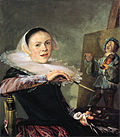File:Boy playing the Flute (Judith Leyster) - Nationalmuseum - 18123.tif
Appearance

Size of this JPG preview of this TIF file: 516 × 599 pixels. Other resolutions: 207 × 240 pixels | 413 × 480 pixels | 661 × 768 pixels | 882 × 1,024 pixels | 1,763 × 2,048 pixels | 3,023 × 3,511 pixels.
Original file (3,023 × 3,511 pixels, file size: 30.38 MB, MIME type: image/tiff)
File history
Click on a date/time to view the file as it appeared at that time.
| Date/Time | Thumbnail | Dimensions | User | Comment | |
|---|---|---|---|---|---|
| current | 04:30, 8 October 2016 |  | 3,023 × 3,511 (30.38 MB) | AndreCostaWMSE-bot | {{Artwork |other_fields_1 = |artist = {{Creator:Judith Leyster}} |title = {{en|Boy playing the Flute}} {{sv|Gosse blåsande flöjt}} |wikidata = Q18573672 |object_type = painting |descripti... |
File usage
The following 4 pages use this file:
Global file usage
The following other wikis use this file:
- Usage on de.wikipedia.org
- Usage on es.wikipedia.org
- Usage on fr.wikipedia.org
- Usage on lt.wikipedia.org
- Usage on nl.wikipedia.org
- Usage on sr.wikipedia.org
- Usage on sv.wikipedia.org
- Usage on www.wikidata.org
- Q18573672
- Wikidata:WikiProject sum of all paintings/Creator/Judith Leyster
- Wikidata:WikiProject sum of all paintings/Catalog/Judith Leyster catalog raisonné 1989
- User:Kringln/Sitelink report
- Wikidata:WikiProject sum of all paintings/Missing depicts/Genre art
- Wikidata:WikiProject sum of all paintings/Collection/Nationalmuseum/17th Century






